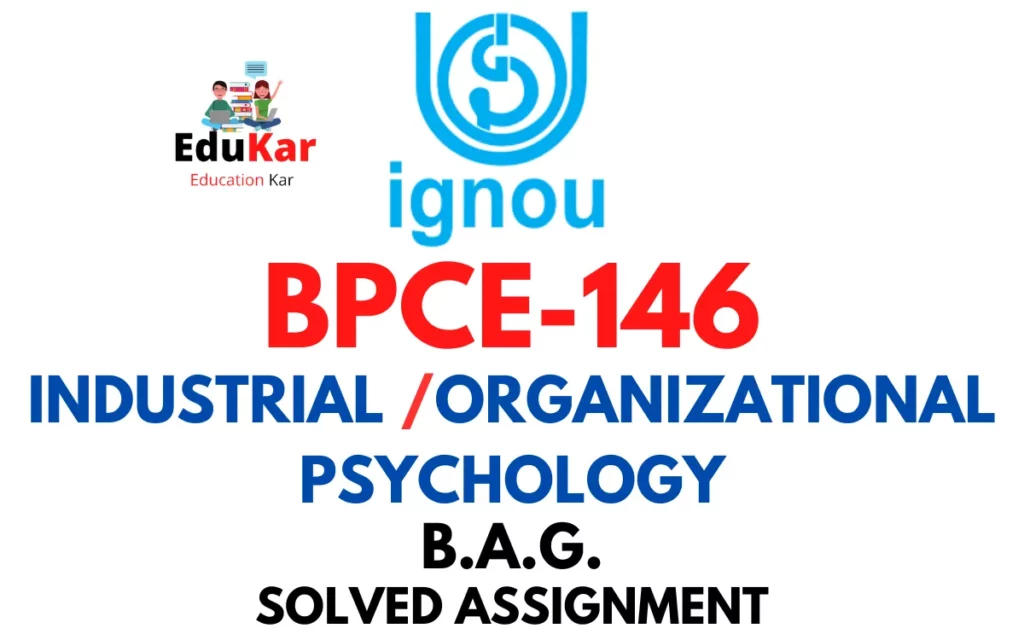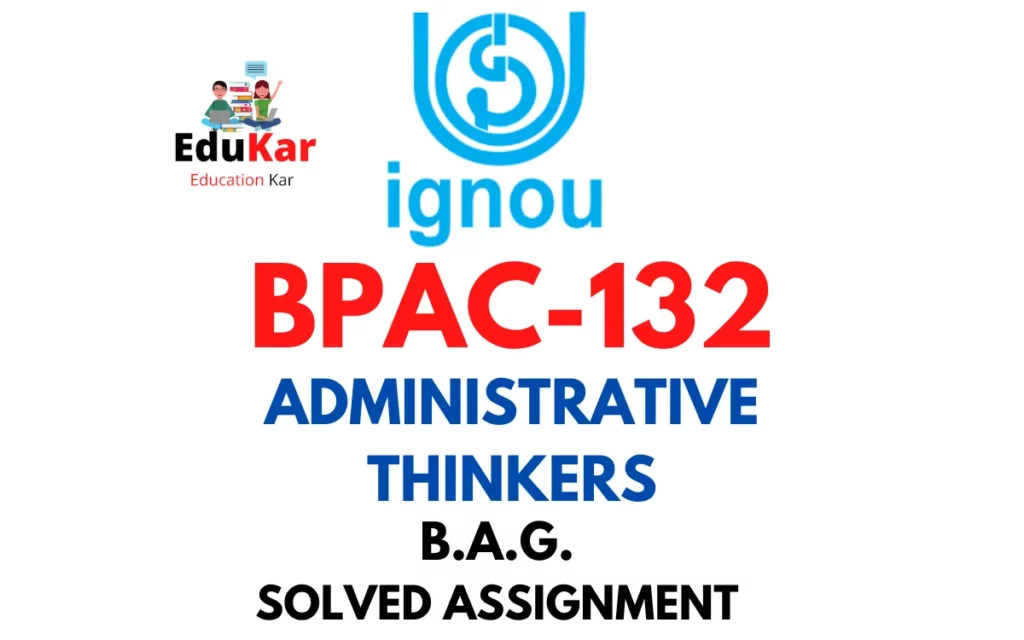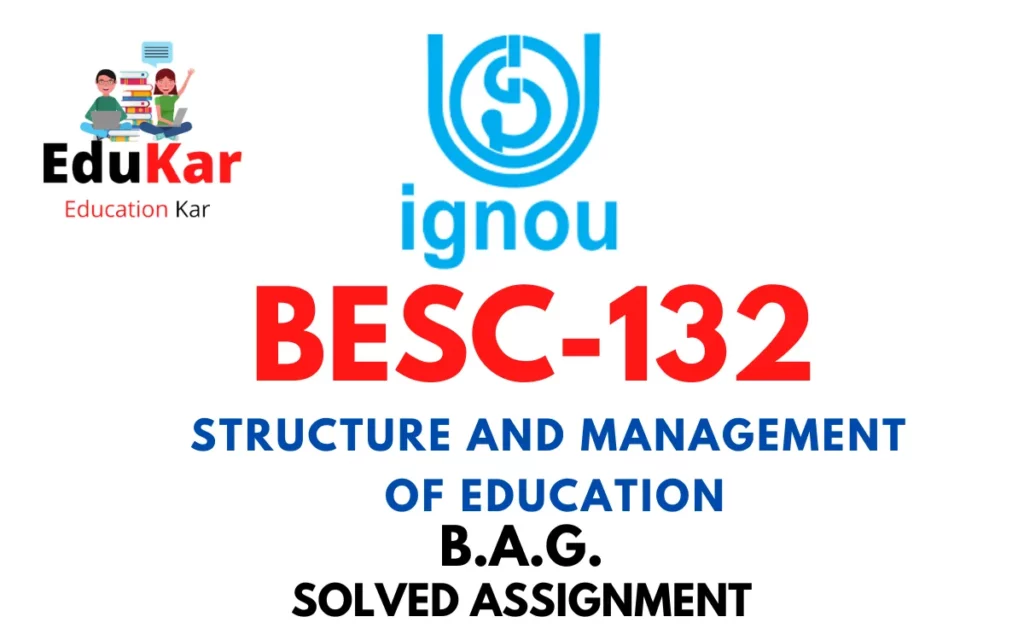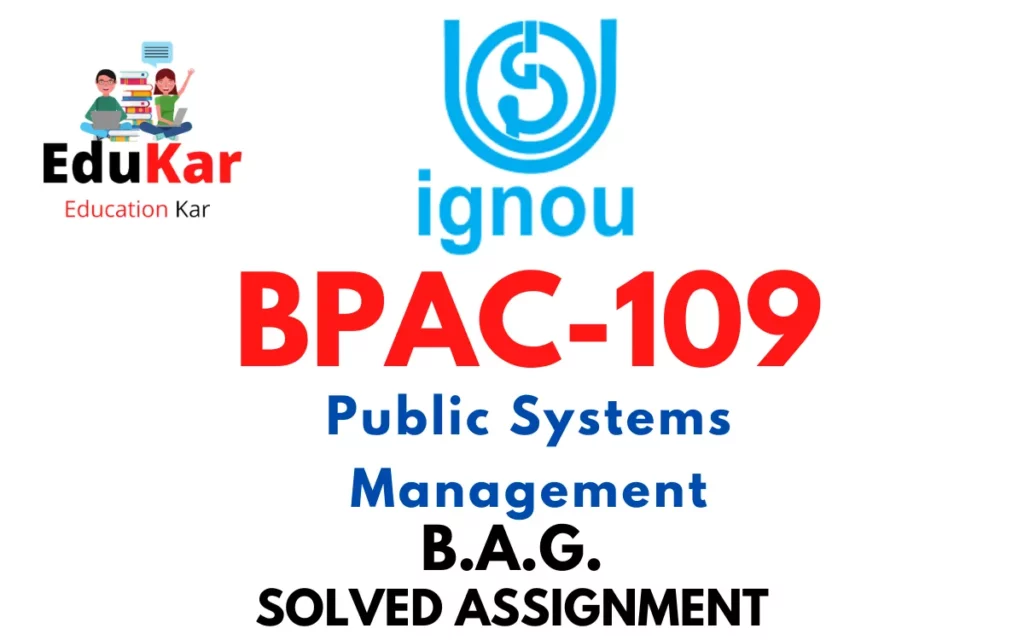Contents
- 1 Assignment A
- 2 Answer the following in about 500 words each.
- 3 1. Write a note on various types of training conducted by training institutions in India.
- 4 2. Describe the various steps in the recruitment process.
- 5 Assignment B
- 6 Answer the following questions in about 250 words each.
- 7 3. Examine the reasons for growing importance of bureaucracy.
- 8 4. Describe the methods of job evaluation.
- 9 5. Discuss the scope of personnel administration.
- 10 Assignment C
- 11 Answer the following questions in about 100 words each.
- 12 6. Explain the role and functions of the Ministry of Personnel, Public Grievances and Pensions.
- 13 7. Discuss the relationship between the government and public services.
- 14 8. Why is promotion necessary in civil services?
- 15 9. What are the components of performance management process?
- 16 10. Describe trade union rights.
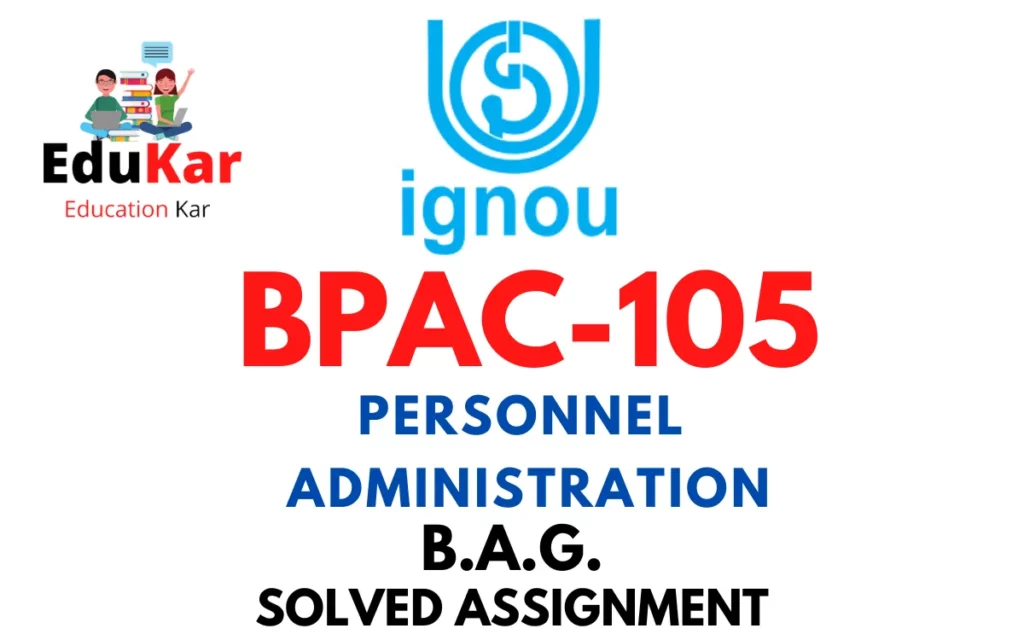
| Title | BPAC-105: IGNOU BAG Solved Assignment 2022-2023 |
| University | IGNOU |
| Degree | Bachelor Degree Programme |
| Course Code | BPAC-105 |
| Course Name | PERSONNEL ADMINISTRATION |
| Programme Name | Bachelor of Arts (General) |
| Programme Code | BAG |
| Total Marks | 100 |
| Year | 2022-2023 |
| Language | English |
| Assignment Code | ASST/TMA/July2022&January2023 |
| Assignment PDF | Click Here |
| Last Date for Submission of Assignment: | For June Examination: 31st April For December Examination: 30th September |
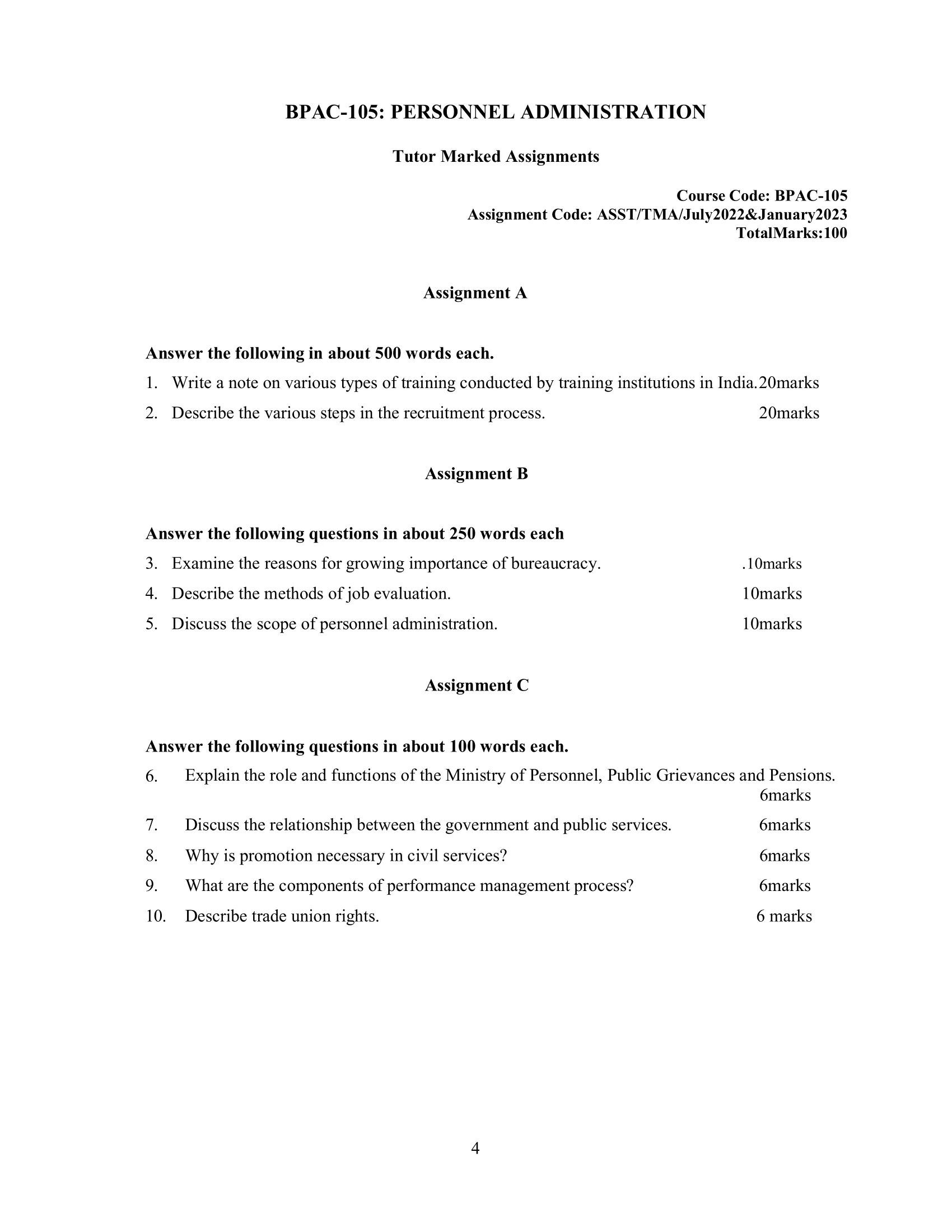
Assignment A
Answer the following in about 500 words each.
1. Write a note on various types of training conducted by training institutions in India.
Ans: Training institutions in India offer a wide variety of training programs to individuals, professionals, and organizations. These training programs are designed to cater to different requirements and needs of the trainees. Some of the common types of training conducted by training institutions in India are:
- Technical Training: Technical training is designed to equip individuals with specific technical skills and knowledge required for a particular job. These training programs include courses such as programming languages, software development, engineering, and data analytics.
- Soft Skills Training: Soft skills training is designed to improve interpersonal and communication skills of individuals. These training programs include courses on leadership, teamwork, time management, and communication.
- Leadership Training: Leadership training is designed to develop leadership qualities in individuals. These training programs include courses on strategic thinking, decision-making, and conflict resolution.
- Sales Training: Sales training is designed to equip sales professionals with the skills required to sell products or services effectively. These training programs include courses on prospecting, closing techniques, and customer relationship management.
- Customer Service Training: Customer service training is designed to improve the customer service skills of individuals. These training programs include courses on communication skills, customer handling, and problem-solving.
- Management Training: Management training is designed to develop management skills in individuals. These training programs include courses on project management, team management, and financial management.
- Technical Writing Training: Technical writing training is designed to equip individuals with the skills required for technical writing. These training programs include courses on technical writing, editing, and proofreading.
- Language Training: Language training is designed to improve the language skills of individuals. These training programs include courses on spoken and written English, foreign languages, and translation.
- Entrepreneurship Training: Entrepreneurship training is designed to develop entrepreneurial skills in individuals. These training programs include courses on business planning, marketing, and finance.
- Computer Training: Computer training is designed to improve computer skills of individuals. These training programs include courses on computer basics, Microsoft Office, and programming languages.
2. Describe the various steps in the recruitment process.
Ans: Recruitment is a crucial process for any organization as it helps in attracting, identifying, and hiring the right talent for the available job positions. The recruitment process involves a series of steps that help organizations in identifying and selecting the most suitable candidates. Here are the various steps in the recruitment process:
- Job Analysis: The first step in the recruitment process is to identify the job roles and responsibilities. This includes analyzing the job requirements, the skills and knowledge required, the responsibilities of the job, and the qualifications needed.
- Sourcing: The next step in the recruitment process is to source candidates for the available job positions. This involves identifying potential candidates through various sources such as job portals, social media platforms, employee referrals, and recruitment agencies.
- Screening: After sourcing potential candidates, the next step is to screen their resumes and applications. This includes reviewing their education, work experience, and skills to determine if they meet the required qualifications for the job.
- Interview: Once the screening process is complete, the shortlisted candidates are called for an interview. The interview process involves assessing the candidate’s knowledge, skills, and behavior to determine their suitability for the job.
- Assessment: In some cases, organizations may conduct additional assessments such as skills tests, personality tests, and aptitude tests to evaluate the candidate’s skills and potential for the job.
- Reference and Background Check: Once the assessment process is complete, the organization may conduct reference and background checks to verify the candidate’s education, work experience, and criminal history.
- Selection: After all the above steps, the organization makes a decision on which candidate to select for the job. This involves considering the candidate’s qualifications, experience, skills, and suitability for the job.
- Offer: Once the candidate is selected, the organization makes an offer to the candidate, which includes the job role, salary, benefits, and other terms and conditions.
- Onboarding: The final step in the recruitment process is onboarding. This involves welcoming the new employee to the organization, providing them with an introduction to the company culture, policies, and procedures, and providing them with the necessary resources to succeed in their new role.
Assignment B
Answer the following questions in about 250 words each.
3. Examine the reasons for growing importance of bureaucracy.
Ans: Bureaucracy refers to a form of government that is characterized by a hierarchical organization, standardized procedures, and a clear division of labor. The growth of bureaucracy in modern societies has been attributed to several reasons.
Firstly, the increasing complexity of modern societies has led to the growth of bureaucracy. As societies have become more complex, it has become necessary for governments to create specialized administrative agencies to handle the various tasks required to maintain order and promote development. This has resulted in the creation of a large number of bureaucratic agencies that are responsible for managing various aspects of society, such as education, healthcare, social welfare, and public safety.
Secondly, the growth of bureaucracy is also driven by the need for accountability and efficiency in government. Bureaucratic procedures, such as standardized rules and regulations, help to ensure that government officials are held accountable for their actions and that the government operates efficiently. Bureaucratic rules and procedures also help to minimize corruption and promote fairness in decision-making.
Thirdly, the growth of bureaucracy is also driven by the need for expertise and specialization. As governments have become more complex, it has become necessary to have officials who are trained and specialized in various fields. Bureaucratic agencies are staffed by officials who have expertise in their respective fields, such as education, healthcare, or finance. This helps to ensure that decisions are made based on sound knowledge and expertise, rather than political considerations.
4. Describe the methods of job evaluation.
Ans: Job evaluation is a process used by organizations to determine the relative worth or value of different jobs within the organization. There are several methods used to conduct job evaluations, and the choice of method depends on the organization’s needs, culture, and resources. Here are some common methods of job evaluation:
- Ranking Method: In this method, jobs are ranked in order of their perceived importance, from highest to lowest. The ranking is usually based on a set of predetermined criteria, such as skill level, responsibility, and knowledge.
- Classification Method: This method involves grouping jobs into predetermined job classes or categories based on the level of complexity, responsibility, and qualifications required. The classification system is often based on a point-factor system that assigns points for different factors such as education, experience, and skill level.
- Point Method: This method assigns points to different job factors, such as skill level, responsibility, and knowledge, to determine the relative value of a job. The job factors are assigned points based on their importance to the organization, and the points are then added up to determine the job’s overall value.
- Factor Comparison Method: This method involves breaking down jobs into different job factors, such as skill level, responsibility, and knowledge, and comparing them to similar factors in other jobs. The jobs are then ranked based on the relative importance of their job factors.
- Hay Method: This is a comprehensive job evaluation method that combines aspects of the point and factor comparison methods. It involves breaking down jobs into three factors: knowledge, accountability, and skills. Each factor is then assigned points based on a predetermined scale, and the points are added up to determine the job’s overall value.
5. Discuss the scope of personnel administration.
Ans: Personnel administration, also known as human resource management, is the process of managing an organization’s human resources to achieve its goals and objectives. The scope of personnel administration is vast and includes several key functions that are critical to the success of any organization. Some of the key functions of personnel administration are as follows:
- Recruitment and Selection: The recruitment and selection function is responsible for identifying, attracting, and selecting the most qualified candidates for a given job. This function includes job analysis, job design, posting job vacancies, screening resumes, interviewing candidates, and selecting the best candidate.
- Training and Development: The training and development function is responsible for providing employees with the skills and knowledge they need to perform their job effectively. This function includes identifying training needs, designing and delivering training programs, and evaluating their effectiveness.
- Performance Management: The performance management function is responsible for managing employee performance and ensuring that employees are meeting the organization’s expectations. This function includes setting performance goals, providing feedback, conducting performance evaluations, and implementing performance improvement plans.
- Compensation and Benefits: The compensation and benefits function is responsible for developing and administering the organization’s compensation and benefits programs. This function includes developing job descriptions, conducting job evaluations, determining pay rates, designing and administering benefit programs, and ensuring compliance with labor laws.
- Employee Relations: The employee relations function is responsible for maintaining positive relationships between the organization and its employees. This function includes developing and implementing policies and procedures, addressing employee grievances, and promoting employee engagement and morale.
- Safety and Health: The safety and health function is responsible for ensuring that the workplace is safe and healthy for employees. This function includes identifying and controlling workplace hazards, developing and implementing safety policies and procedures, and providing training and education on safety and health issues.
Assignment C
Answer the following questions in about 100 words each.
6. Explain the role and functions of the Ministry of Personnel, Public Grievances and Pensions.
Ans: The Ministry of Personnel, Public Grievances and Pensions is a ministry of the Government of India that is responsible for managing the country’s civil services and personnel administration. The Ministry is headed by a Cabinet Minister and supported by two Ministers of State.
The Ministry is responsible for formulating policies related to the recruitment, training, and career development of civil servants in India. It also oversees the functioning of the Union Public Service Commission, which is responsible for conducting civil service examinations for recruitment to various positions in the government.
In addition, the Ministry is responsible for the management of the Central Government’s pension policies and schemes. It also handles the public grievance redressal mechanism through its Centralized Public Grievance Redress and Monitoring System (CPGRAMS) and other grievance redressal mechanisms.
The Ministry of Personnel, Public Grievances and Pensions plays a critical role in ensuring the effective functioning of the civil services in India. Its functions include the formulation and implementation of policies related to personnel management, training, and career development, ensuring transparent and efficient grievance redressal mechanisms, and managing the Central Government’s pension policies and schemes.
7. Discuss the relationship between the government and public services.
Ans: The relationship between the government and public services is critical for the functioning of a modern democratic society. Public services are the various services provided by the government to its citizens, including healthcare, education, transportation, law enforcement, and social welfare programs. The government is responsible for ensuring the effective delivery of these services to the public.
The government plays a vital role in the provision of public services by providing funding, resources, and policy direction to various public service organizations. The government also regulates public services to ensure that they are delivered in a fair, equitable, and efficient manner. The government may establish standards for public services, set guidelines for performance, and ensure accountability.
Public services, in turn, provide critical services to citizens that they cannot obtain from the private sector. They provide services that are necessary for the well-being and development of the society, such as healthcare, education, and social welfare programs. Public services are also responsible for maintaining law and order, protecting citizens from harm, and providing infrastructure for transportation and other basic needs.
The relationship between the government and public services is a complex one, as there are often competing demands, limited resources, and differing interests. Public service organizations must balance the needs of the public with the resources available to them, while the government must balance the demands of the public with the need to maintain fiscal responsibility.
To ensure an effective and efficient relationship between the government and public services, there must be clear communication, collaboration, and cooperation. The government must provide adequate funding and resources to public services, while public services must provide transparent, accountable, and effective services to the public. The government and public services must also work together to develop policies and programs that address the needs of the public, promote social justice, and ensure the well-being of society as a whole.
8. Why is promotion necessary in civil services?
Ans: Promotion is necessary in civil services for several reasons, which are discussed below.
- Career Development: Promotion provides civil servants with a means to progress in their careers. It is a recognition of their hard work, dedication, and competence. Promotions provide employees with new opportunities to learn, develop new skills, and take on new responsibilities.
- Retention: Promotion is an essential tool for retaining talented employees in the civil services. Employees who feel that their work is valued and are provided with opportunities to grow and develop are more likely to remain committed to the organization.
- Performance Management: Promotion is also an essential tool for managing employee performance. The process of promotion involves a review of the employee’s performance, which can identify areas where improvement is necessary. It also encourages employees to continue performing at a high level.
- Motivation: Promotion can be a significant motivator for employees in the civil services. The prospect of being promoted can encourage employees to work harder, learn new skills, and take on new challenges. The feeling of accomplishment that comes with a promotion can also be a powerful motivator.
- Succession Planning: Promotion is an essential part of succession planning in the civil services. It helps to ensure that there is a pool of talented and experienced employees who are ready to take on leadership roles when they become available.
9. What are the components of performance management process?
Ans: Performance management is a continuous process that involves a range of activities aimed at ensuring that employees are meeting the expectations and goals of the organization. The components of the performance management process typically include:
- Goal Setting: This involves establishing clear and specific performance goals for each employee, aligned with the organization’s strategic objectives.
- Performance Planning: This involves creating a plan for how the employee will achieve their performance goals. This may include identifying the skills, resources, and training necessary to achieve the goals.
- Performance Monitoring: This involves monitoring the employee’s performance throughout the year to ensure that they are on track to achieve their goals. This may involve regular feedback sessions, coaching, and check-ins.
- Performance Evaluation: This involves assessing the employee’s performance at the end of a performance cycle. This may include a formal performance review, where the employee’s achievements, strengths, and areas for improvement are discussed.
- Performance Improvement: This involves identifying areas where the employee needs to improve and creating a plan to address those areas. This may involve additional training, coaching, or other support.
- Recognition and Reward: This involves recognizing and rewarding employees for their performance. This may include bonuses, promotions, or other incentives.
10. Describe trade union rights.
Ans: Trade union rights refer to the legal protections and privileges granted to trade unions and their members to promote and protect their collective interests. Some common trade union rights include the right to form and join a union, the right to bargain collectively with employers, the right to strike, the right to representation in the workplace, and protection against discrimination or retaliation for union activities. These rights vary by country and jurisdiction, but they are generally designed to ensure that workers have the ability to organize and advocate for better wages, benefits, and working conditions. Trade union rights are an essential component of labor law and are critical to ensuring that workers are able to exercise their rights and improve their working conditions.
How to Download BPAC-105 Solved Assignment?
You can download it from the www.edukar.in, they have a big database for all the IGNOU solved assignments.
Is the BPAC-105 Solved Assignment Free?
Yes this is absolutely free to download the solved assignment from www.edukar.in
What is the last submission date for BPAC-105 Solved Assignment?
For June Examination: 31st April, For December Examination: 30th October





